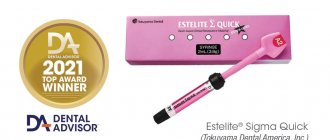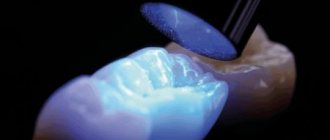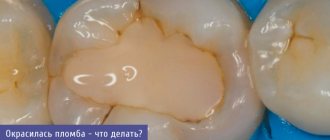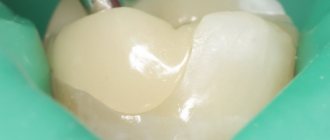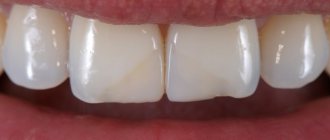Statistics from dental practice confirm the fact that light fillings are most often used and are gradually replacing other filling materials. This happens due to the objective advantages and high performance of fillings in practice.
Specialists from the network of dental clinics "LeaderStom" use light fillings of the latest developments and recommend this material for the restoration of crowns and the elimination of caries. If you notice the first signs of tooth decay and plan to eliminate it in a timely manner, then the LeaderStom clinic will be able to provide you with exactly the quality that meets the most progressive standards of dentistry.
Ceramic filling CEREC with a 50% discount
Heliocomposite composition
To understand how a light filling differs from a regular one, you need to know its composition and principle of operation. Light-curing fillings consist of a polymer matrix, glass-ceramic filler and bonding material. The principle of polymerization is a substance that breaks down into free radicals under the influence of ultraviolet rays. These radicals are responsible for the hardening of the material. The quality of stability and strength of the material depends on the size of the particles in the filler.
They can be: • mini-filled; • macro-, micro-filled; • nanohybrid.
The choice of material composition is determined by the dentist, based on hardness parameters or decorative priority.
The light filling performs the function of protecting tooth tissue from mechanical and chemical irritants. It prevents pathogenic microbes from entering the tooth and withstands significant daily loads. Therefore, the requirements for the quality of filling material are very high, and the light filling fully lives up to the expectations placed on it.
Fillings based on cement compositions: pros and cons
| Distinctive features | Short description |
| Advantages of modern cement filling materials: |
|
| Disadvantages of compositions based on microcements: |
|
The dental clinic on Michurinsky "Diamant" in Moscow treats all forms of caries, its complications, and also eliminates damage to dentin. You can find out exactly how much a tooth filling costs only after an initial examination by a dentist. Make an appointment and come to Diamant - we will do everything to make you forget about the pain as soon as possible!
Durability
The average lifespan of light seals is about five years. However, in practice, they can keep the tooth intact for much longer. For greater durability of the filling, dentists at the LeaderStom clinic recommend carefully monitoring oral hygiene, proper nutrition and sufficient calcium intake into the body.
Stable fastening of the light filling is achieved through an adhesive system - a special light-sensitive liquid that is used to treat the tooth walls. Performing the function of “glue”, it so firmly connects the photopolymer material with the tooth enamel that subsequently a chemical calcium exchange begins to occur between these tissues.
What to do for a patient who has had a light filling?
The patient, in principle, should not perform any special actions at all if he has received a light filling. How long after you can eat and drink depends on the foods and liquids. For the first two hours, you should not bite anything hard or sticky with a filled tooth, since not all chemical bonds between the filling and the enamel have been established. After two hours, you can subject the tooth to moderate chewing load, and after a day you can eat food of any hardness.
It is also worth considering the risk of staining. For example, patients ask: if a light filling is installed, can you drink coffee? This drink is one of the most staining - in the first three days (on a fresh filling) it is better not to drink it. The same goes for strong black tea, beetroot dishes, pomegranate and other fruit juices rich in pigments, as well as red wine. So you can drink coffee with a light filling after three days, and the entire subsequent time, while it remains in place, the shade of the filling will not change from this drink.
Sometimes a fresh photopolymer filling causes slight pain - this is considered normal, and any discomfort usually disappears within half an hour to two days after filling.
Regular care of a filled tooth is no different from the usual care of whole teeth - regular rinsing and standard cleaning with a brush and paste are necessary. Also, fillings made of photopolymer materials do not suffer when using dental floss and toothpicks.
Biological compatibility
It is known that filling material such as amalgam, which was used several years ago for dental treatment, contains mercury in its composition. Another material, glass ionomer cement, is also used in dentistry, but contains fluoride, which recent research suggests may be harmful to the pineal gland. In this range of filling materials, light fillings are distinguished by their maximum biological compatibility. They do not emit toxic substances, do not destroy the tooth crown (as cement composites do due to higher hardness than the tooth), and have optimal expansion-compression characteristics under temperature changes.
Stages of composite restoration
The restoration method takes place in several stages.
- The first step is to administer local anesthesia if processing or grinding is necessary.
- The second point is preparing the tooth: cleaning it from plaque, fillings, leveling the surface.
- Next, the prepared tooth is isolated using a latex scarf with a hole for the tooth.
- Then, the restoration itself: layer-by-layer application of the composite material, followed by adjustment to the natural shape of the tooth and illuminated with a special lamp.
- At the last stage, final grinding, grinding, polishing is carried out - the tooth surface becomes ideal, smooth and naturally shiny.
The entire recovery procedure takes less than an hour.
High aesthetic characteristics
The aesthetic factor is especially important when eliminating caries on the front teeth. The material of the photo light seal lends itself perfectly to final processing: grinding and polishing. And the color set provided by raw material manufacturers includes the full range of possible shades of tooth enamel. This fact allows you to accurately imitate the natural color of the tooth in the absence of boundaries between the enamel tissue and the filling. Even after several years of use, it can be quite difficult to determine this boundary, and immediately after tooth restoration it is simply impossible.
The effect of preserving tooth color gradations is possible thanks to the use of the latest layer-by-layer application technologies. The so-called polychrome filling uses more than two color components: darker at the base of the tooth and lighter towards the cusps. The most modern compositions of filling materials used in the LeaderStorm clinic were developed using nanotechnology. They allow you to achieve maximum aesthetic effect when restoring a tooth.
There are rare exceptions when priority is given to chemical composites. For example, when installing the material in a place that is difficult to reach for ultraviolet radiation. If a tooth restoration is carried out with a light filling, then the light polymerization will not be effective and the composite will not harden properly. In such situations, a chemically cured material is recommended.
All of the above advantages of light seals, reviews are very positive, which is confirmed in practice.
What is a filling?
A tooth is a very durable formation that can withstand many cycles of chewing food, is not afraid of cold and hot foods, and in its normal state does not cause discomfort to a person. However, caries in an advanced form can make the patient’s life unbearable: the dental tissue is gradually destroyed, cavities are formed in it, in which harmless bacteria multiply under normal conditions, and as a result, the disease affects the nerves located inside the bone, which leads to severe pain.
Filling teeth, front or molar, helps:
- Restore chewing functions.
- Restore lost aesthetics to your smile.
- Stop the proliferation of pathogenic microorganisms.
To install a filling on a tooth, the price is determined by the volume, complexity of the work (how badly the bone is damaged, whether the nerves are affected), the location (where the filling is performed), the anesthetic drugs used, and the choice of filling material. The question of how much it costs to put a filling on a tooth can be answered accurately, knowing whether the patient needs a temporary or permanent filling, whether it will be installed from scratch or a replacement of a poorly made filling in another clinic. "Diamond" will help everyone - come to us and forget about constant pain!
What does a light-curing filling consist of?
Basically, for all types of fillings, a mixture of several materials is used. Composite light fillings have a complex chemical composition, which to some extent is why the cost of a light filling in Moscow is higher.
Components that make up the light seal:
- The heliocomposite base, breaking down into radicals under ultraviolet radiation, starts the process of polymerization (hardening) of the material itself.
- Filler – silicon dioxide, glass ceramics. The structure, color and area of application of the filling depend on it.
- Connecting elements.
Treatment of dental caries with filling
The main type of treatment for caries is dental filling. It implies that after removing the affected tooth tissue and medicinal treatment, the carious cavity will be completely filled with filling material. The procedure will isolate sensitive tooth tissues, prevent microbes from entering the resulting cavity, and restore the health of the tooth, its functional characteristics and aesthetics. Without a filling, caries is treated only at the very initial signs of damage. The effectiveness of dental filling and its longevity directly depend on several factors:
- The professional skills of the doctor performing the procedure, his strict adherence to the protocol, and the thoroughness of the manipulations.
- The quality of the tools and materials used.
The effectiveness of caries treatment will significantly increase the correct choice of filling. Today, the dental market is provided with a wide range of different filling materials. The main option used in dentistry is composite.
What are composite materials
Dental composite is a multicomponent material.
The combination of two or more substances with different properties produces a new material with improved characteristics. Dental composites consist of a filler (this inorganic component accounts for at least 30% of the total volume of the filling) and an organic matrix. The size of the filler particles and its quantity serve as the basis for the classification of dental fillings. The filling index affects the strength and degree of shrinkage of the filling, and therefore must be taken into account when planning the procedure. The doctor proceeds from what tooth needs to be filled and what properties of the filling are the priority.
Based on the polymerization (hardening) method, dental composites are divided into composites
- light curing;
- chemical curing (self-curing).
Features of a light-curing filling
A light-curing filling (light, light composite, photo composite, heliocomposite) is the best material today used in therapeutic and aesthetic dentistry, intended for sealing cavities in the tooth after caries, pulpitis, periodontitis and restoring damaged teeth.
Unlike its predecessors, self-curing fillings, which quickly harden as a result of mixing chemical components, a light filling acquires the necessary hardness only under the influence of ultraviolet radiation. Before light is directed at it, it remains plastic. The dentist, without rushing, without limiting himself to time frames, can clearly and carefully fill the cavity and shape the shape of the tooth. According to professionals, no other material is able to cope with the task at such a high level.
A photocomposite filling consists of a main filler and a substance that is sensitive to a certain spectrum of blue rays, wavelength 450 nm, ultraviolet light. Its source is usually halogen lamps or, more preferably, LEDs, which do not have the disadvantages of thermal radiation. When radiation hits a filling, the photoinitiator releases active radicals, and in the filling already formed by the dentist, they trigger active polymerization processes, that is, hardening.
The most popular options for light-curing composite materials are EsteliteQuick, Gradia (Japan). Filtek, Harmonize, HerculiteUltra, Ceram X (USA).
How to treat caries with the installation of a light filling
Installing a light filling is a rather lengthy process, the result of which is a healthy tooth. The step-by-step procedure looks like this:
- The dentist examines the damaged tooth and clarifies the situation using x-ray diagnostics. Considering that a significant part of the tooth is hidden in the thickness of the gum, the study will reveal the involvement of the dental pulp in the pathological process. Having received all the information, it will be possible to more clearly plan the course of further activities and take care of creating comfortable conditions for the patient.
- If necessary, local anesthesia is used. The use of these drugs will be especially in demand if we are talking about the fact that not only hard tissues, but also tooth canals are subject to filling.
- Using a drill, the dentist removes destroyed tissue and processes the carious cavity to more conveniently fill it with filling material.
- Medicinal treatment of the inner and outer surfaces of the tooth is carried out.
- The tooth is isolated from saliva. The greatest effect is achieved using a cofferdam, a latex napkin designed to separate one or more teeth from the rest of the mouth.
- The doctor dries the surface of the tooth so that the remaining saliva does not affect the quality of the filling. Its remains under the layers of the filling will disrupt the tightness of the future restoration and will certainly worsen the result.
- Using a special color scale, the desired shade of the filling is selected. The resulting cavity is filled layer by layer with a light-curing filling. This happens in such a way that a layer is applied, then with the help of light it is dried until hardened, after which it is covered with a new one. Since photocomposite is a soft and pliable material, it can be used to easily eliminate defects and simulate the desired tooth shape.
- Applying the top coat requires special attention. The dentist will have to recreate the surface of the tooth so that its anatomical shape reaches its original state. Before directing the ultraviolet beam to the top layer, the dentist makes sure that the tooth interacts correctly with the antagonists.
- After the final exposure to light and complete hardening of the filling, it is ground and polished. These actions provide both additional aesthetics of the tooth, making the filling as similar in appearance as the enamel, and guarantee a preventive effect. The smooth surface of the tooth prevents the formation of plaque and the action of cariogenic bacteria.
The entire process of installing a light seal will take about an hour.
Indications and contraindications for installing a light filling
Indications for using a light-curing filling are:
- Restoration of defects in the front teeth that form the smile zone, including the elimination of chips;
- Damage or destruction of the lateral teeth, if they can be accessed by an ultraviolet lamp;
- The need to build up the crown part of the tooth;
- Elimination of defects of non-carious origin;
- Correction of abnormalities in the shape and color of teeth.
Contraindications for the use of light-curing fillings:
- Significant dental defects, constituting more than half of the surface of the crown part of the tooth. In such cases, the issue can be resolved with the help of ceramic inlays made in the laboratory.
- Hard-to-reach areas where it is impossible to ensure sufficient polymerization.
Advantages of using light-curing fillings
Filling caries with a light-curing filling allows you to count on obtaining the most advantageous results. Benefits of the procedure:
- The fact that hardening of the material occurs only when exposed to light radiation allows the procedure to be carried out with ideal quality. The option when the material becomes hard even before the doctor has provided the desired result is excluded.
- High efficiency of the procedure. Thanks to the strength and durability of the material, it is possible to restore a tooth even if half of its tissues are destroyed.
- Large palette of shades. The dentist can choose a color that fully matches the natural tooth of a particular person. Thanks to this property, it is possible to achieve excellent results when filling front teeth. At the same time, chemical-curing fillings will not cope with this task, since upon contact with oxygen the material changes its properties, which negatively affects aesthetics.
- Excellent indicators of material plasticity, when it is possible to achieve a clear restoration of the anatomical shape of the tooth.
If chemical fillings can only fill existing cavities, then with the help of light fillings it will be possible to form even missing parts of the tooth. This feature is an important factor in severe tooth decay.
- Safety, absence of side effects, which is why such a filling can be used in children and pregnant women.
- Almost instantaneous adhesion to the tooth. Within an hour you can eat freely.
- Durability.
Disadvantages of light filling
Disadvantages of light-curing fillings: The first and main disadvantage is the high cost. Experts point out a number of other limitations:
- This option cannot be used in hard-to-reach places when cervical caries of “sevens” and “eights” have to be treated. The difficulties are due to the fact that the light of an ultraviolet lamp does not reach their surface, so high-quality hardening is impossible.
- After completion of treatment, it is not recommended to eat food with coloring pigment for several days. Compliance with this condition will allow you to maintain the aesthetics of the filling for a long time.
Service life of the light seal
A light seal lasts about 5-7 years. This indicator is influenced by the following prerequisites:
- Correct choice of material;
- The quality of the work done;
- Follow-up dental and oral care. Hard foods such as crackers, as well as chewing gum and products with a viscous texture always increase the risk of fillings falling out.
Prices for light-curing fillings at CosmeticDent
Installing a light-curing filling will cost more than using other materials. At the same time, it is quite fair that, having spent money, every patient expects to receive an aesthetic, reliable and long-term filling result. This will require not only the use of high-quality materials, but also certain skills of the dentist and his experience in using this type of filling. To exclude any mistakes based on the doctor’s insufficient competence, contact the CosmeticDent clinic in Moscow. We guarantee high quality dental treatment. The center’s specialists have extensive experience in using photocomposites and will be able to cope with the problem in the most severe clinical cases. You can also count on an impeccable filling result because our clinic will be able to install an EsteliteQuick filling. Over the past 10 years, this Japanese material has occupied a leading position in the rankings conducted by professionals. In 2022, he was awarded the highest award.
Popular questions:
– What material is best to fill teeth? At the present stage, there are a large number of high-quality, safe materials that make it possible to obtain an aesthetic and long-term option for filling. The choice of a specific filling depends on whether the teeth are baby or permanent, as well as their location (frontal or chewing). The materials used are in a wide price range, so when choosing you have to take this indicator into account.
Prices for services
| Tooth crown restoration or composite veneer | 7530 rub. |
| Filling with light-curing composite 1 surface | 3450 rub. |
| Filling with light-curing composite 2 surfaces | 4480 rub. |
| Filling with light-curing composite 3 surfaces | 6020 rub. |
| Installation of composite pins - per 1 tooth | 2710 rub. |
| Tab | 15700 rub. |
| Cementing a crown (inlay) onto a composite material | 1450 rub. |
To accurately determine the final price of treatment, sign up for a consultation at Dental Diamond and we will draw up a treatment plan. Use the phone numbers listed on the website or fill out the call back form.

